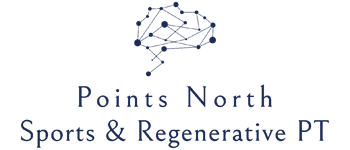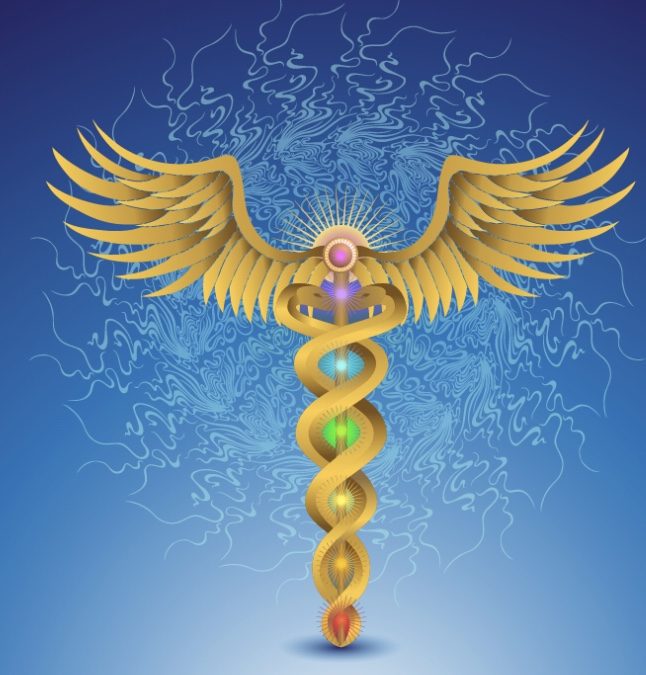In our nation, acceptance, open-mindedness, new ideas and knowledge abound, and despite all the stereotypes of Western medicine, the U.S. health care system exhibits these qualities as well. I think it is appropriate to tell you right here and now that I have been trained in the U.S. health care system. I graduated from a physical therapy program at a top U.S. medical school and did my clinical rotations in hospitals, rehab centers, outpatient facilities, and home care agencies. When I hear terms frequently used to describe U.S. health care–traditional, closed-minded, reactive, disconnected—I understand what people are saying; I do think , however, that it is our health care payment system, which strongly influences the delivery of health care services, that gives rise to this negative bias. I think we all can agree that business controlling health care delivery is a dysfunctional relationship.
Not infrequently, people stride into my clinic and announce, “I don’t believe in Western medicine.” What? My immediate response to this statement is, “Well then, you may not have come to the right clinic for you, because I’m Western medicine-trained.” Despite our catastrophe of a health insurance system, U.S. health care is the best in the world. Other countries send their students here to train. Our doctors and health care professionals are sent to other countries to help out in areas desperate for quality health care. And trust me, the people who don’t believe in Western medicine are suddenly all in when they suffer a medical emergency. I have wondered why people who think they don’t believe in Western medicine frequently come to see me. All I can come up with is that my very physiologically based soft tissue and joint mobilization techniques are gentle and may be confused with energy work and therefore have a reputation for being something other than what they are.
Let’s stop for a moment and define the term “Western medicine.” Also known as “allopathic medicine” or “conventional medicine,” “Western medicine” describes the medical system developed in the nations of the Western hemisphere where a delineation exists between health and a disease state. The disease state is assessed through hypothetical deductive reasoning. Treatment options are evidence-based. Research supported treatment options traditionally have consisted of medications, radiation, surgery, and referrals to rehab.
But I have watched the face of Western medicine changing during my 20-year career, and research and clinical evidence are promoting a more proactive and full-body approach. Doctors whom I am fortunate to know and work with routinely send over clients for help with exercise programs and weight loss, or for myofascial release treatments, a soft tissue technique used to address pain and limited mobility, formerly considered within the realm of “alternative.” Doctors also are referring clients to gyms, yoga, massage, acupuncture, and counseling for help with stress, chronic pain, and lifestyle issues. Lifestyle, stress management, mental and emotional health, family issues and safety are frequently discussed during an intake at a visit.
Orthopedic surgeons and sports medicine doctors, who fearlessly and cheerfully perform physically and mentally exhausting operative procedures that give patients their lives back, for decades have had to endure the rep of being a gang of ex-jocks who are gung ho on the subject of surgery and who view joints as separate, disconnected entities from one another. These doctors now defy that stereotype by encouraging clients to exercise, change their lifestyle, lose weight, mix up their activities; in other words, try other options before resorting to surgery. They also are recognizing the effects that one joint can have on another part of the body, and send over referrals to treat the entire chain, not just one joint.
Even our stodgy, cranky health insurance system is having to catch up. Most health insurances now cover annual well visits and physicals. Many cover chiropractic treatment, and some are starting to cover services such as massage and acupuncture, and even occasionally can be convinced with a letter from a doctor to cover a gym membership.
Given the movement within U.S. healthcare toward a proactive, whole-body approach with recognition of the influence that lifestyle and stress can have on the human body, there still exists a rather salty, frigid relationship in our country between Western medicine and all other less traditional health-related practices, lumped together under “alternative medicine.” It isn’t openly aggressive, like the Greasers versus the Socs in The Outsiders, the Union versus the Confederacy in the Civil War, or the Suunis versus the Shiites in the Middle East. It’s more like relatives who don’t have much to do with each other and are forced to get together at a wedding and pose for a family photo. “Western medicine” is the preppy, conservative relatives who among themselves express snarky distaste for the crazy “alternative medicine” side of the family, the embarrassing relatives dressed inappropriately for the event who are arguing with each other and everyone else and screeching for attention.
Often it is PTs who are the most obnoxious of the conservative side of the family and vehemently critical of the embarrassing relatives. This is because we were saved from having to hang out with those people only recently by nationwide direct access, granted in 2015 by Congress after an epic battle between the APTA and the American Medical Association. And we’re still trying to cozy up to some of the conservative old relatives for acceptance, a few of whom still aren’t all that interested in dealing with us. Of course some of the relatives on each side ignore the family dynamics, recognize each other’s good qualities and forge a good working relationship with the others for the sake of the unsuspecting clients caught in the middle of it all.
Alternative medicine in the U.S., however, no longer can be ignored. More and more people are gravitating toward alternative practices, frequently when they are frustrated with the delivery system of U.S. health care, or when they continue to suffer from symptoms that elude diagnosis by Western medicine. It even has its own official government agency known as the National Center for Complementary and Integrative Health (NCCIH), which happens to be one of the 27 agencies and centers that comprise the National Institutes of Health. Based on my quick, cursory review of recent research projects funded by the NCCIH, it seems that much of the research is devoted to debunking odd ideas, such as whether coffee enemas cure pancreatic cancer, or energy healers can cure cholesterol-fed rabbits. But studies demonstrating the ineffectiveness of useless, possibly dangerous and likely expensive treatments is as important to medicine as those which demonstrate the efficacy of treatment. One can find information on the NCCIH website regarding various forms of alternative medicine, and the efficacy and safety of various alternative practices.
Two legitimate forms of Eastern medicine, traditional Chinese medicine (abbreviated as TCM) and Ayurvedic, or Indian medicine, are quietly and uncomplainingly holding their own in the vast, crazy sea of alternative medicine, and I believe they both deserve more attention. Both have been practiced for thousands of years, originating in China and India, respectively, and these practices have spread throughout many other countries. They are evolved medical systems with their own diagnostic methods that are unlike Western medical diagnostics. Both systems view all components of the human body as one continuum, and focus on balance and imbalance of the body, mind, and spirit. In health, all are in balance; a disease state is a state of imbalance.
Please allow me to say that I have not studied either system extensively and cannot comment on different diagnoses or treatments within each system. I approach medications and supplements with great caution, particularly when it comes to supplements that are not FDA-approved. I have seen clients experience toxic reactions to taking substances they know nothing about, and have had a couple of adverse reactions myself. What intrigues me about TCM and Ayurvedic practices is the emphasis on the balanced versus imbalanced states of the human being, and the significance of energy in both forms of medicine. These components of diagnosis and treatment are unmeasurable and unquantifiable in Western medicine and therefore are not part of our medical model of hypothetical deduction. And after working within our system for 20 years, I have realized that there is much that we still do not understand. The concepts of energy and imbalance could play a role in solving the mysteries of symptoms that persist despite a battery of tests with negative results, as well in addressing the epidemic of non-communicable diseases in the Western world.
Both of these Eastern systems mapped out diagrams of energy centers and channels thousands of years ago. I would not dare to offend practitioners of TCM by trying to simplify and explain the very intricate and complex system of energy meridians–channels that conduct and store energy within the human body. But I will comment that a diagram of the 12 primary energy meridians maps out the components of the central nervous system and the major branches of the peripheral nervous system, long before anything was known about the structure and function of the nervous system. So we could speculate that ancient practitioners of TCM were able to tap into the energy of the nervous system—the ion exchange and subsequent depolarization of the nerve cell membrane, generating an electric signal that travels down the length of the nerve fiber.
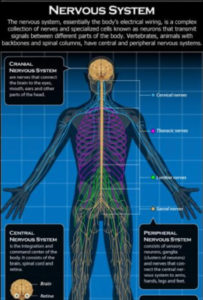
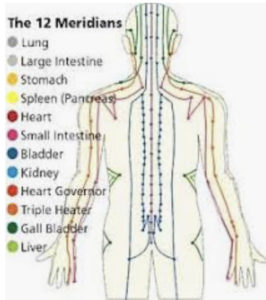
Ayurveda integrates into its practice in the concept of prana, a vital life force, that circulates through channels called nadis. At the risk of serious oversimplification, points of intensity where the nadis connect or intersect are called chakras. There are believed to be 88,000 chakras in the human body. Ancient Hindu text describes 21 primary chakras in the human body, although Modern Ayurvedic medicine observes seven primary chakras, which are also observed in the practice of yoga.
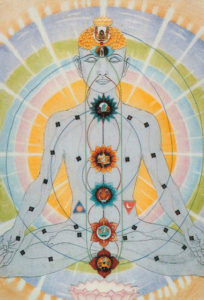
The primary chakras are thought of as major energy centers in the body. Each of the seven chakras corresponds to an organ or endocrine gland. If a blockage occurs somewhere in the channels, an imbalance occurs in the chakras. One or more may be underactive or overactive. Each chakra, when in balance, is responsible for organ function as well as human emotions, needs and behavior. Signs and symptoms, physical complaints, mental state, and emotions help to identify an imbalance in the chakras, according to Ayurveda.
Since electricity is a modern-day form of energy, and electric impulses generated by electron movement are responsible for many important functions of the human body, why are we in the Western medical system dismissive of the concept of energy at work in the human body? The answer is twofold: First, no one has quite figured out how to view energy in the body via imaging, or how to quantify and measure it. Western health care is rooted in scientific inquiry and method and seeks concrete answers to questions, an admirable standard when health and safety of those who depend on us to take care of them are at stake. If we can’t measure it or even see it, then we have no proof that it exists and have no business treating it. I do think we are on the fringes of discovery. Heat and inflammation in the body can be viewed via imaging, and the electrical impulses of brain activity as well as in the peripheral nervous system can be viewed and measured. So clearly we are onto something.
The second reason why U.S. health care and mainstream American culture has been reluctant to embrace the concept of energy as it relates to the human body, I think, is because of the “woo woo” mystique surrounding all forms of freaky energetic healing amok in the category of alternative medicine. This perception is unfortunate when useful forms of treatment get lost in the shuffle. Reiki, for example, is a practice of energy work that is gaining more and more acceptance, and Reiki treatment and classes actually are now offered in hospitals, rehab centers and other health care facilities. The general public skepticism of practices involving energy work, however, tends to result from the frequent depiction of energetic “healers” fed by movies, TV, and the Internet as nutty people with wild hair, wearing flowy outfits, waving crystals and incense, and calling upon spirits. After 20 years of working with the public, I can tell you that some of these people actually do exist. While they usually are lovely people who just want to help others using whatever their method is, I understand the general public hesitation because I don’t want weirdness involved in my health care, either.
If we view the human body as a giant battery, due the electron exchange across a cell membrane propagating nerve signals from the brain to the spinal cord to the peripheral nerves and back—that make our hearts beat and our muscles move our joints, and allow us to communicate effectively, to love, to feel and express emotions, and to process data from our environment that forces us to learn and evolve—then it seems less crazy that something that disrupts the electron exchange, such as a mechanical injury to the area or a major illness, could throw the ionic balance responsible for the electron exchange out of whack.
Flashback to two years ago: Brilliant yoga goddess and good friend AP was a good sport and came to a craniosacral seminar that I was teaching. As I was demonstrating an Upledger craniosacral 10-step protocol on her so she could see what it would feel like, she exclaimed, “Kathleen! This is crazy! These pressure points correspond to all the chakras!” I knew little to nothing about the chakras but naturally, everything AP tells me about inspires me to do more reading. And then I discovered something earth-shattering.
In the clinic, I have noted an alignment pattern of the cranium, spine, sacrum, pelvis, and coccyx that I have come to call “stressed out alignment,” and it is not reflective of the daily stresses of life in our culture, or even a stressful month. I know before these clients tell me, and sometimes it takes a few sessions before they do, that something significant has impacted their health in the past. It could result from a head injury or other physical trauma such as a bad accident or severe illness. It also could result from a severe episode of emotional stress—illness or loss of a loved one, a traumatic experience, or history of abuse or other absolutely intolerable home situation. The dysfunction in the alignment pattern occurs at seven significant points, and I believe the changes occur due to overfacilitation of the central nervous system. What I realized later after my conversation with my friend and subsequent research is that these points on the musculoskeletal system correspond to the location of the seven major chakras identified in Ayurveda: The root chakra at the sacrum and coccyx; the sacral chakra at L3, L4 and L5; the solar plexus chakra at T12; the heart chakra at T4-T6; the throat chakra at C3-C5; the third eye chakra at the bones of the upper facial vault; and the crown chakra at the cranial vault.
In the case of a severe emotional trauma, the primary alignment dysfunction tends to occur in the area of the heart chakra around T4-T6, but can extend from T1-T8, which then can affect the points above and below it, significantly in the lumbar spine, sacrum, and pelvis. This pattern is reflected as well in the TCM diagram of the 12 primary meridians mapped out on the posterior side of the body. Several meridians cluster around the thoracic spine and then travel inferiorly, intersect with other meridians in the area of the sacrum, and then converge to travel down the back of each lower extremity, as well as up into the head, where they parallel other meridians traveling into the upper extremities.
It’s interesting stuff. I have no plans to abandon my training and leap into energy healing. My scope of practice lies within the physical and physiological realm. And neither are my thoughts on energy a call for all of us to abandon the U.S. health care system en masse and adopt Eastern medicine as our primary health care. Not at all. No way. I believe it’s always best to start with Western medicine to rule out an underlying organic issue.
What I think I am seeing is an alignment pattern that reflects a major past or current stress to the central nervous system, which untreated, contributes to illness and dysfunction by throwing the neural firing off kilter in areas of the body. I have not yet undertaken a research study on my own with regards to this topic but hope to someday soon. My own clinical evidence suggests, however, that after applying physical therapy treatment techniques to the injury or condition for which a client seeks assistance, I have noted that clients who exhibit this dysfunctional alignment pattern frequently report feeling better overall when the alignment pattern improves. They may report a better sense of well-being, improved breathing, more energy, decreased fatigue, and improved athletic performance. Occasionally they report that other transient as yet undiagnosed symptoms they experience from time to time have resolved. Transient pelvic pain, heart palpitations, headaches, and tinnitus are examples.
Improving the firing pattern of the nervous system by applying treatment techniques that improve the alignment of the spine is Western medical terminology. Achieving balance through unblocking channels to improve energy flow might be the equivalent Eastern medicine terminology, or the language of other alternative practices striving to treat energetic issues. This treatment goal might be accomplished via a treatment or combination of treatments from Western medicine, Eastern medicine, and other legitimate alternative disciplines, including but not limited to: surgery, injections, physical therapy, acupuncture, yoga, osteopathy, chiropractic, or massage.
In a society where stress and overload are routinely making people sick, it’s time to think about balance and the effect of extreme stress on the central nervous system. Balancing does not mean running off to an expensive, uncredentialed energy healer instead of a medical doctor. Once significant medical issues are ruled out, one could augment self-healing with some central nervous system-calming mediation, and self-examination independently or with the help of counseling. In a society where intuition is suffocated by demands, busyness, and people-pleasing, rediscovering intuition also is important. Your intuition may point the way with regards to thoughts, people, situations, and life issues that exacerbate or diminish symptoms–those that are exhausting and drain our energy, and those that replenish and re-energize us. This process could be very exciting and lead you in the direction of improved diet, a consistent, effective, fun and calming exercise routine, new friends, and career and other lifestyle changes.
As I’ve been saying for years—the more I learn, the more there is to learn.
–Kathleen Doehla, M.S. P.T.
